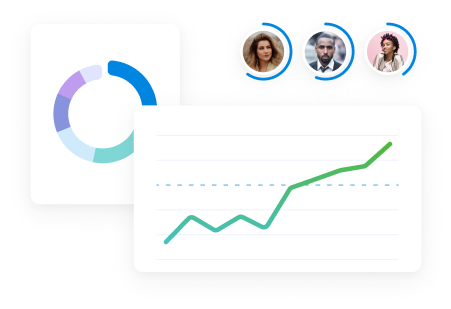In your haste to get started on a new project, you might be tempted to skip some of the formalities of introductions. Indeed, many people opt to forgo an initial project kickoff meeting, making a very costly mistake in the process.
Imagine being sat around a table with your project’s stakeholders and being greeted with the terrifying realization that no one is getting what they expect from a project you have already started. That, right there, is the reason why you should always hold a meeting to ensure that everyone understands the purpose of your project, and how you’ll meet each stakeholder and team member’s aims.
What is a Project Kickoff Meeting?
A project kickoff meeting is a very simple and effective way to make sure everyone is on the same page before the project work begins. By meeting the project team and other stakeholders, you can ensure you all agree on the purpose of the project and align on key details.
The ideal time to host your project kickoff meeting is after you have created your project plan but before any of the work begins. That enables you to make sure that you’re all in agreement about everything from the deliverables and milestones to the next steps before you enter the project execution phase.
Hosting a project kickoff meeting gives you an effective way to communicate key project information to your team and provides them with an opportunity to answer any questions that they may have.
Of course, these details could be shared over email, but hosting a physical or virtual kickoff meeting allows them to be discussed live. This reduces the risk of miscommunication and makes sure that everyone’s expectations are aligned.
The different types of project kickoff meetings
Who attends and what you cover depends on whether it’s an internal or an external project kickoff meeting.
Internal project kickoff meetings
This is the simplest form of project kickoff meeting.
The goal is to get the project team aligned and allow them to ask questions and air any concerns before the work begins.
For an internal meeting, your project kickoff checklist should include:
- Identifying and introducing all team members
- Assigning team roles and responsibilities
- Discussing how the project team will communicate throughout the project
- Providing background information about the client and project
- Setting the project’s goals and objectives
- Detailing the expectations for success
- Agreeing on the project timeline and completion date
- Identifying any potential problems
- Addressing any questions or concerns
As well as getting everyone on the same page and instilling confidence in the project team, the internal meeting will also help you and the project team prepare for the kickoff meeting with your clients.
External project kickoff meetings
If you’re working on a client-facing project, then you should also host a kickoff meeting between key members of the project team and important stakeholders on the client-side.
The aim of this meeting is to agree on the project goals and deliverables so that expectations are aligned.
Your project kickoff meeting agenda for an external meeting should include:
- Introducing the team
- Discussing how you will communicate with the client during the project
- Agreeing on how frequently you will communicate
- Clarifying what aspects of the project (if any) you will collaborate on
- Agreeing on success metrics and a project schedule
- Clearly defining the project scope and setting clear boundaries on what is and isn’t part of the project
- Sharing a project roadmap that will include a timeline and the relevant project milestones
- Discussing what the review, approval, and change request process will look like
How to Run a Project Kickoff Meeting
Okay, so now we’ve discussed what a project kickoff meeting is and what it involves, but as the project manager, how do you run one? The likelihood is that you’ll be the person driving the meeting, so you need to know what you’re doing and the steps you should take.
1. Create an agenda
Your first job, even before the meeting begins, is to create and send out an agenda for your project kickoff meeting so that everyone is prepared and knows what to expect. Time is precious when you’re kick-starting a project and you’ll only have a short window for this initial meeting, so creating an agenda in advance helps to make sure that no time is wasted.
This is also the perfect opportunity to share any documents and materials that you’re going to discuss during the meeting. That includes the project plan, the project scope, the deliverables, and the timeline.
At the end of your project kickoff meeting, you should allow plenty of time for questions. The goal is for everyone to leave the meeting on the same page, so let them ask questions about any of the information you’ve provided or particular task expectations.
2. Explain the purpose of the project
The most important thing to get out of a project kickoff meeting is for all of the stakeholders to understand what you’re collectively working towards. That might sound simplistic, but your team members must know how their work relates to the overall goal.
Explaining what you are working towards, and why, is central to this. You can then break the overall objectives down into more specific project details and workflows. As an example:
“The purpose of this project is to create a new website and digital brand campaign that increases our client’s brand awareness.”
You can then expand on this further by discussing:
- The goals of the project
- The expected deliverables
- What is within the project scope and what isn’t
- The project plan
Marketing agencies can use project management software like Scoro to document and share these essential project details with the project team. Different levels of access can also be assigned to every stakeholder so they only have access to the documents that are relevant to them.
3. Be clear about timelines and workload
When running an external project kickoff meeting, always be clear about what you need to deliver and how long it’s going to take. This meeting sets the tone for the whole of the project, so you must be very clear. If you’re not, then you could live to regret it in the form of scope creep, unrealistic expectations, and deadlines that you cannot meet.
Being open in this early stage will keep you and the client on the same page from the off. You can then use project management software like Scoro to share updates and give them visibility of the project right there on your Scoro site. They can keep track of real-time project progress, collaborate and give feedback, and oversee the project budget. That helps you to manage expectations and keep your clients up to date throughout.
4. Decide how you’ll communicate
The average project worker can waste a huge amount of time chasing information and searching for documents. With so many communication channels available – be it emails, instant messaging apps, in-document notifications, phone calls, and client meetings, it’s not always easy tracking down the information you need.
That’s why, before you bring your meeting to a close, you should give your project team details of the communication channels you will use. It is highly beneficial to create a single source of truth for all of your project work. It makes it easy for your team to get real-time updates, locate project documents, check on relevant project milestones, and stay updated on project deliverables, all within a single piece of software.
5. Outline the next steps and follow up
The final box to tick on your project kickoff checklist is to explain what comes next in terms of the steps you and your project team will take. If you captured action items during the meeting then make sure that they are assigned to the most appropriate team member.
After the Project Kickoff Meeting
You might have put blood, sweat and tears into your kickoff meeting, but now comes the real hard work. After all, there’s no guarantee that your project will be plain sailing. However, using the right tools to keep everyone on track will certainly help.
And that’s where Scoro comes in. It acts as a central source of truth and collaboration for everyone involved, helping to maintain alignment and clarity between all of your project stakeholders. You can share work updates, project progress, and messages all in one place, so you can keep everyone involved in the project on the same page.




